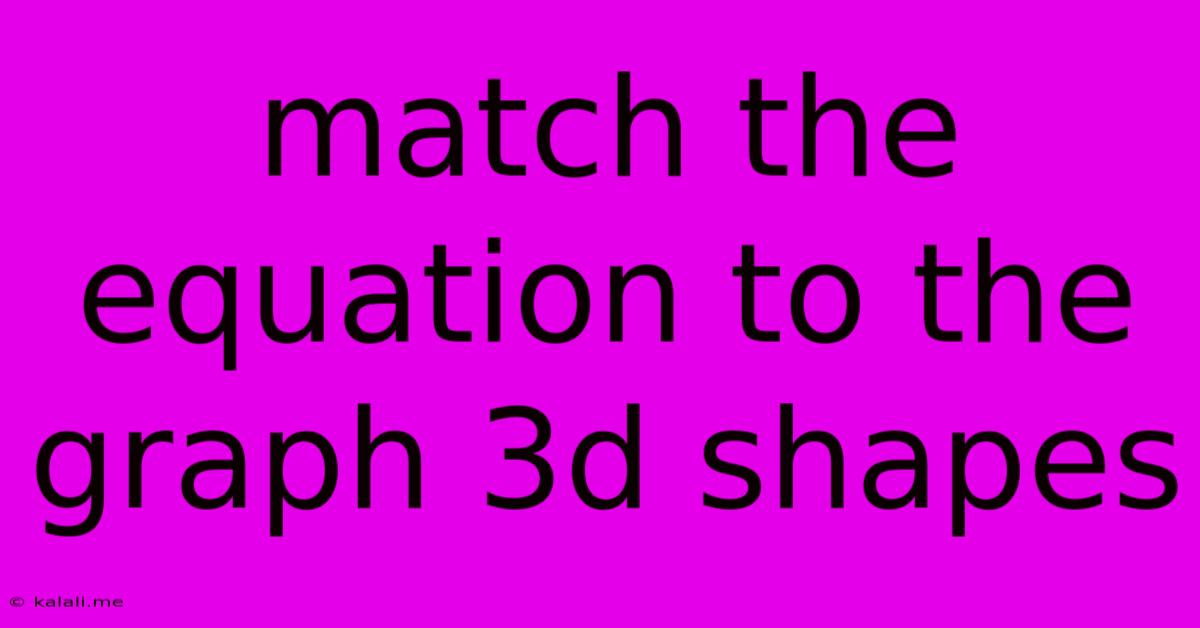Match The Equation To The Graph 3d Shapes
Kalali
May 25, 2025 · 3 min read

Table of Contents
Matching Equations to 3D Shapes: A Comprehensive Guide
Understanding the relationship between mathematical equations and their corresponding three-dimensional shapes is crucial in various fields, from computer graphics and engineering to architecture and data visualization. This article provides a comprehensive guide to identifying the 3D shapes represented by common equations, enhancing your spatial reasoning and mathematical skills. We'll explore several key equation types and their visual representations. This guide will help you confidently match equations to their 3D graph counterparts.
Understanding the Basics:
Before diving into specific equations, let's establish a foundation. Three-dimensional shapes are defined in space using three coordinate axes (typically x, y, and z). Equations describe the relationship between these coordinates, defining the points that form the shape's surface. The complexity of the equation often correlates with the complexity of the resulting 3D shape. We will be focusing on recognizing common shapes, simplifying the task of matching equations to their graphs.
Common 3D Shapes and Their Equations:
Here are some of the most frequently encountered 3D shapes and the equations that represent them:
1. Sphere:
A sphere is a perfectly round geometrical object in three-dimensional space, defined by its center and radius. Its equation is remarkably simple:
- Equation: x² + y² + z² = r² where 'r' is the radius of the sphere.
This equation defines all points (x, y, z) that are equidistant from the origin (0,0,0). The larger the 'r' value, the larger the sphere.
2. Cylinder:
A cylinder is a three-dimensional solid with two parallel circular bases and a curved surface connecting them. While cylinders have more intricate surface area calculations, the equation for a right circular cylinder aligned with the z-axis is:
- Equation: x² + y² = r² (for a cylinder of radius 'r' extending infinitely along the z-axis).
This equation describes the circular cross-section at any height along the z-axis. Variations exist for cylinders not aligned with an axis.
3. Cone:
A cone is a three-dimensional geometric shape that tapers smoothly from a flat base (frequently, though not necessarily, circular) to a point called the apex or vertex.
- Equation: x² + y² = (z/h)² * r² (for a cone with height 'h' and base radius 'r').
This equation, similar to the cylinder, describes a circular base which shrinks to a point as 'z' approaches the cone's height.
4. Ellipsoid:
An ellipsoid is a three-dimensional generalization of an ellipse. It's a closed quadric surface that resembles a stretched or compressed sphere. Its equation is an extension of the sphere's equation:
- Equation: (x²/a²) + (y²/b²) + (z²/c²) = 1 where 'a', 'b', and 'c' represent the semi-major axes along the x, y, and z axes respectively.
The values of 'a', 'b', and 'c' determine the ellipsoid's shape and orientation. If a=b=c, it simplifies to a sphere.
5. Paraboloid:
Paraboloids are quadric surfaces which resemble a parabola rotated around its axis of symmetry. There are elliptic and hyperbolic paraboloids. A simple elliptic paraboloid equation is:
- Equation: z = x² + y²
This equation creates a bowl-shaped surface opening upwards. Changing the coefficients before x² and y² can alter the shape.
Tips for Matching Equations to 3D Graphs:
- Identify key features: Look for clues in the equation, such as the presence of squared terms (indicating circular or elliptical cross-sections), the presence of only one squared term (suggesting a parabolic shape), or the absence of squared terms.
- Consider the axes: Pay attention to which variables are squared and which are not. This helps determine the orientation of the shape.
- Start with simple cases: Begin by identifying the simplest shapes first (spheres, cylinders). Then move on to more complex ones.
- Use graphing tools: Online graphing calculators or software can be invaluable for visualizing equations and verifying your matches.
By understanding these fundamental shapes and their equations, you'll develop a stronger intuition for visualizing three-dimensional forms from their mathematical representations, enhancing your skills in multiple fields. Remember to practice regularly to solidify your understanding and improve your ability to effectively match equations to 3D graphs.
Latest Posts
Latest Posts
-
Bash Read Lines Into Multiple Variables
May 25, 2025
-
How To Loosen A Wheel Nut
May 25, 2025
-
Stepper Motor Driver Soem Does Not Work Control Frequency
May 25, 2025
-
Check The External Field Of The Error Object
May 25, 2025
-
Can You Use Linseed Oil Over Painted Wood
May 25, 2025
Related Post
Thank you for visiting our website which covers about Match The Equation To The Graph 3d Shapes . We hope the information provided has been useful to you. Feel free to contact us if you have any questions or need further assistance. See you next time and don't miss to bookmark.